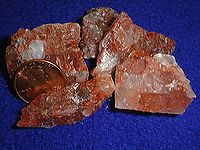
Photo from wikipedia
Enrichment of biochars to produce slow nutrient release fertilizers with minimal losses to the environment is a promising strategy. However, the release of potassium (K) from biochar-based fertilizer produced from… Click to show full abstract
Enrichment of biochars to produce slow nutrient release fertilizers with minimal losses to the environment is a promising strategy. However, the release of potassium (K) from biochar-based fertilizer produced from sewage sludge (SS) is still poorly studied. In the present 30-day incubation study, the dynamics of K release were evaluated from SS biochar-based fertilizers enriched with potassium chloride (KBF) in different forms, subjected to two levels of silica sand moisture (10 and 20%). The KBF was evaluated in the form of granules, pellets and powder, in addition to pure KCl mineral fertilizer. During the incubation period water-soluble K extractions were performed, where the K contents were adjusted to K release kinetic models. An additional experiment was performed to assess the effect of KBFs and KCl on K leaching. In general, at both moisture levels all KBFs presented a slower K release compared to pure KCl mineral fertilizer, reducing the release rate by up to 77%. The K release dynamics were affected by the type of biochar fertilizer (granule, pellet and powder) and the silica sand moisture level. The behavior of KBFs as slow-release fertilizers is strongly dependent on the silica sand moisture level. At the 10% moisture level, biochar fertilizers in the form of pellets and granules can be classified as slow-release fertilizers with the potential to increase the efficiency of K use in agriculture. Furthermore, compared to the chemical fertilizer, KBF reduced the amount of leached K, diminishing the risk of this nutrient polluting the groundwater. Our results must be further assessed in real conditions using soil as a suitable medium for agronomic and environmental evaluation. Therefore, future studies should consider the dynamic of K and other nutrients from KBFs in distinct soil types.
Journal Title: Journal of environmental management
Year Published: 2022
Link to full text (if available)
Share on Social Media: Sign Up to like & get
recommendations!